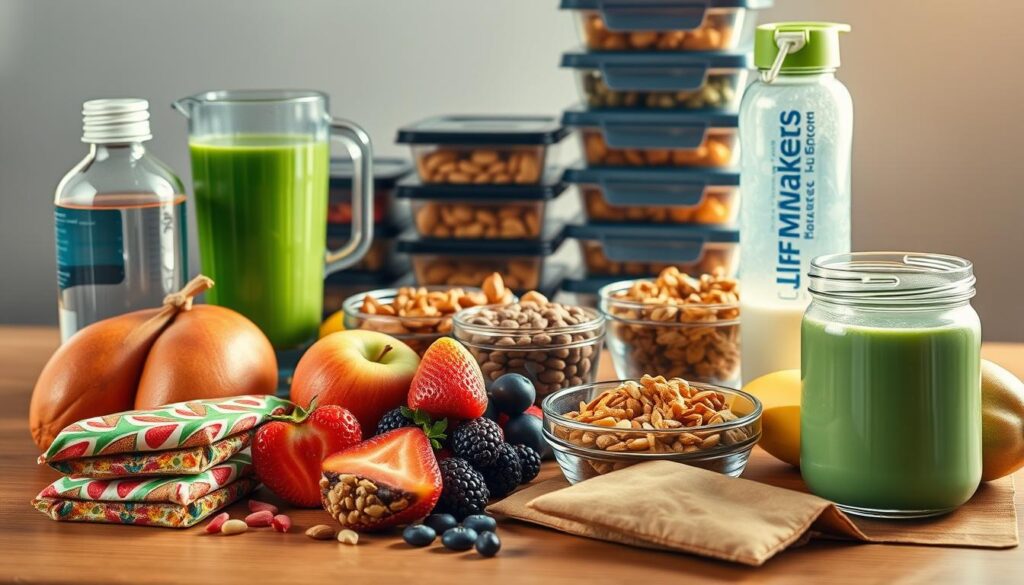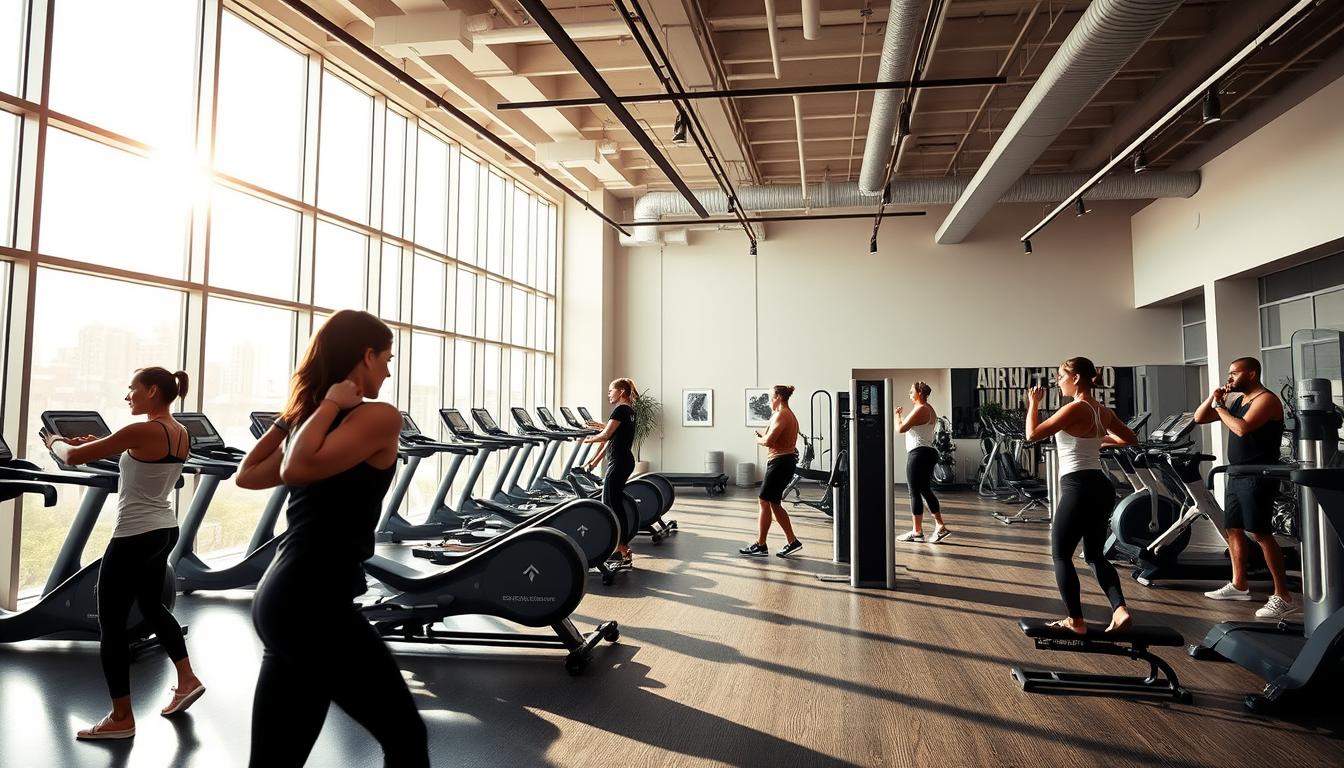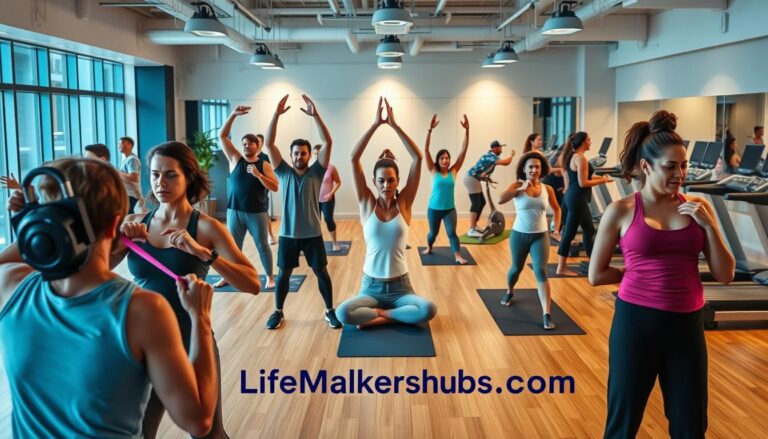Fitness Workouts: Unlock Your Body’s Full Potential
Effective fitness routines don’t have to be hard. Whether you’re busy or love working out, this guide shows how to boost your energy and health. It all starts with knowing what works and why.
Studies show that full-body workouts three times a week can boost your metabolism and burn fat. They can even build strength in under 90 minutes. Even with a tight schedule, these workouts fit right in.
Many adults say they can’t fit in workouts because of time. But, with smart planning, time becomes an opportunity. This guide is here to help you overcome barriers.
Full-body training works all major muscles, preventing plateaus and keeping workouts interesting. Kevin’s 30-year journey shows that changing your routine can avoid injuries and keep you moving forward.
Key Takeaways
- Full-body workouts twice to thrice weekly maximize muscle growth and recovery.
- Post-workout nutrition with a 3:1 carb-to protein ratio speeds glycogen restoration.
- 7–9 hours of sleep and 15–20 minute post-workout carb intake fuel progress.
- 70% of people see better results with clear fitness goals—start small and track wins.
- Alternating exercises every 2–3 weeks prevents plateaus and reduces injury risk.
Every body needs a fitness plan that fits its needs. Let’s dive into science-backed strategies for lasting change. Are you ready to start? The journey begins here, with steps you can take today.
The Science Behind Effective Fitness Workouts
Ever wonder how lifting weights or a jog changes your body? Let’s explore the exercise physiology behind your sweat sessions. Every rep and stride triggers tiny changes that boost your fitness transformation. Here’s what happens under the surface and how to use that knowledge to your advantage.
How Exercise Transforms Your Body at the Cellular Level
When you lift, run, or stretch, your body changes in ways you can’t see. Resistance training causes tiny tears in muscle fibers, which your body repairs stronger than before—this is hypertrophy. Aerobic exercises like cycling boost mitochondria in cells, improving energy production. Here’s how different workouts target your body:
- Slow-twitch fibers fuel endurance activities (e.g., long walks), while fast-twitch power short bursts (e.g., sprinting).
- High-Intensity Interval Training (HIIT) combines both energy systems, burning calories and boosting metabolism.
- Muscle soreness post-workout? That’s your body signaling it’s rebuilding—critical for growth.
The Mind-Body Connection in Physical Training
“Your brain is your best workout partner.”
Workout science shows exercise sparks endorphins, reducing stress and sharpening focus. Mental focus during lifts or runs isn’t just psychological—it primes muscles for better performance. Studies prove active recovery (like yoga or walking) enhances recovery by 20% compared to total rest. Pairing mental intent with movement maximizes both physical and mental gains.
Measuring Fitness Progress: Beyond the Scale
Track results with these actionable metrics for your fitness transformation:
| Measurement | How to Track |
|---|---|
| Strength Gains | Log weights lifted and reps completed. |
| Endurance | Time or distance achieved during cardio sessions. |
| Body Composition | Use a body fat percentage calculator or regular photos. |
Focus on consistency—300 reps of an exercise build muscle memory, while periodizing your plan prevents plateaus. Your body isn’t just moving—it’s evolving. Now, let’s turn science into results.
Understanding the Five Major Components of Physical Fitness
Think of your fitness journey like a puzzle—each piece matters. The five fitness components are the base of good physical conditioning. If you skip one, your progress might slow down. Let’s explore each one:
| Component | What It Means | Examples |
|---|---|---|
| Cardiovascular Endurance | Heart and lung efficiency during sustained activity | Running, swimming, cycling |
| Muscular Strength | Ability to lift or carry weight | Deadlifts, push-ups, squats |
| Muscular Endurance | Repeating movements without fatigue | Yoga, circuit training, rowing |
| Flexibility | Range of motion in joints | Stretching, Pilates, ballet |
| Body Composition | Ratios of fat, muscle, and bone mass | DEXA scans, BIA tests |
“A balanced exercise approach reduces chronic disease risk by 30-50%.”
True fitness isn’t just lifting weights or running marathons. Physical conditioning means working on all five areas. For instance, stronger muscles help burn more calories, and better flexibility keeps you safe during workouts. The ACSM suggests 150 minutes of cardio a week and strength training twice a week.
Don’t skip flexibility or body composition. Without it, you risk injuries or health problems. A balanced exercise plan includes cardio, strength, and flexibility. Use body composition tests like BIA machines to track your progress. Focus on all five fitness components to build a strong, healthy body.
Cardio Workouts: Boosting Endurance and Heart Health
Cardiovascular training is more than just sweating. It’s key to living longer. Heart-healthy workouts like running or cycling protect your heart and burn fat. Studies show 30 minutes a day, five days a week, can cut heart disease risk by up to 35%. Are you ready to pick your workout?
HIIT vs. Steady-State Cardio: Which Burns More Fat?
- HIIT: 20-minute bursts (e.g., sprint intervals) trigger the “afterburn effect,” burning calories for hours post-workout.
- Steady-state: 45-minute walks or swims build endurance steadily—ideal for beginners.
A 2021 study in Circulation found both methods boost HDL cholesterol. But HIIT offers faster fat loss for those short on time.
Popular Cardio Activities for Every Fitness Level
| Activity | Intensity | Best For |
|---|---|---|
| Walking | Moderate | Beginners |
| Swimming | Moderate | Joint-friendly options |
| Cycling | High | Advanced/weight loss goals |
| Rowing | High | Total-body fat-burning exercises |
Incorporating Cardio Into Your Weekly Routine
Balance is key! Try this sample weekly plan:
- Monday: 30-minute brisk walk (heart-healthy workouts)
- Wednesday: 20-minute HIIT bike sprints (fat-burning exercises)
- Friday: 45-minute swim
Pair with 2 days of strength training weekly for full-body benefits. Mix activities to avoid plateaus—your heart and metabolism will thank you.
Strength Training Fundamentals for Total Body Transformation

Building strength is more than just lifting heavier weights. It’s about changing how your body moves and feels. Whether you’re new or experienced, these basics make every workout count.
Free Weights vs. Machine Workouts
Free weights work your stabilizer muscles, teaching you how to move in real life. Machines are great for beginners or when you’re recovering from an injury. Resistance bands are as effective as traditional tools and are perfect for home or gym use. Pick what fits your goals: free weights for explosive power or machines for controlled muscle work.
- Free Weights: Build grip strength and core engagement.
- Machines: Focus on specific muscles with guided motion.
- Bands: Portable and scalable for all fitness levels.
Progressive Overload: The Growth Engine
Progressive overload means safely pushing your limits. Add 2.5–5 pounds each week, or increase reps before weight. The NASM OPT Model phases guide you, starting with stabilization before moving to strength and power. Keep track of your progress in a journal, noting every rep, weight, and rest time.
- Increase weight by 5% when lifting 12+ reps easily.
- Slow down eccentric (lowering) phases to boost muscle tension.
- Alternate between full-body and split routines to target growth patterns.
Split Routines vs. Full-Body Workouts
Full-body sessions build overall strength development in just 3 days a week. They’re perfect for those with busy schedules. Splits focus on specific muscle groups, ideal for muscle building techniques targeting weak areas. Mix both for balanced gains!
- Full-Body: 45-minute sessions with squats, rows, and presses.
- Splits: Upper/Lows, Push/Pull/Legs, or body part-specific days.
- Tip: Newcomers start full-body to build baseline strength first.
Consistency is key—pair this with proper rest and nutrition. Every rep counts when you’re intentional. Ready to choose your path?
Flexibility and Mobility: The Overlooked Pillars of Fitness
Ever wonder why your workout feels stuck? Flexibility and mobility might be the key. While strength and cardio get most attention, ignoring these can lead to plateaus. Let’s explore how stretching techniques, joint mobility drills, and injury prevention can boost your progress.
Flexibility and mobility are crucial for better performance. A study found that focusing on both can reduce injury risk by up to 50%. Here’s how to get started:
- Dynamic stretches (leg swings, arm circles) before workouts to prep joints
- Static holds (hamstring stretches, hip flexor releases) post-workout to improve recovery
- PNF stretching (partner-assisted or self-applied) to target stubborn muscle tightness
| Benefit | Impact |
|---|---|
| Injury reduction | 30% fewer workout injuries with consistent flexibility work |
| Joint health | 15-20% gains in joint mobility from weekly drills |
| Performance boost | 10-15% strength gains linked to improved movement quality |
“Movement quality defines longevity in activity,” says Dr. Peter Attia, highlighting the importance of mobility for lifelong fitness. His research shows that middle-aged adults adding 10-15 minutes of daily mobility routines cut muscle tightness complaints by 40%.
Begin with 5 minutes of stretching techniques each day. Focus on major joints like hips, shoulders, and thoracic spine to boost joint mobility. Remember, every workout should include a mobility component. Your body adapts to daily activities—so prioritize movement quality.
Creating Your Personalized Fitness Workout Plan
Creating a workout plan that fits your lifestyle is crucial for lasting success. Workout planning begins with knowing where you start and setting a path that grows with you. Here’s how to make a plan that meets your goals and schedule.
Assessing Your Current Fitness Level
Start by checking your baseline with simple tests. Track your:
- Cardio endurance: Time/distance walked, jogged, or cycled
- Strength: Max reps of bodyweight exercises or initial weights used
- Flexibility: Sit-and-reach test or yoga pose ranges
- Body composition: BMI and waist circumference measurements
“Begin your journey by setting SMART Goals; specific, measurable, achievable, relevant, and time-bound goals.”
Setting SMART Fitness Goals
SMART fitness goals make vague ideas into clear steps. For instance:
- “Lose 5% body fat in 10 weeks” (specific, measurable)
- “Complete 3 resistance training sessions weekly” (achievable, time-bound)
- “Improve 200m sprint time by 10 seconds by month’s end” (relevant, trackable)
Adapting Your Plan as You Progress
Every 4-6 weeks, check your exercise programming with these steps:
- Retest baseline metrics to gauge progress
- Increase weights by 2.5-5% for strength
- Add 1-2 new movements to prevent plateaus
- Adjust rest periods—reduce by 15-30 seconds per set
Remember, consistency is more important than being perfect. Start small and build lasting habits.
Essential Equipment for Effective Fitness Workouts
Not every workout needs a full gym. Start with bodyweight exercises like push-ups or squats. They build strength without any gear. But, the right workout gear can really help improve your results. Let’s look at the must-haves for your home gym and fitness goals.
“Quality equipment isn’t about owning everything—it’s about owning what works.” – NASM Certified Trainer Sarah Mitchell
Start with home gym equipment that saves space and is versatile. Resistance bands, like Fit Simplify’s 5-band set, cost less than $20. They offer strength gains similar to free weights. Adjustable dumbbells, like Bowflex’s 5–52.5 lb SelectTech 552, save space by not needing multiple weights. Stability balls and medicine balls add core training options for under $50.
- Foundational Basics: Resistance bands, adjustable dumbbells, yoga mats
- Core Tools: Stability balls, medicine balls, foam rollers
- Advanced Add-ons: Cable machines, treadmills, or rowers for full-body routines
Start with affordable fitness accessories. The TriggerPoint Grid foam roller helps with muscle knots for $35. For under $100, FLYBIRD’s weight bench supports bench presses and rows. But, bigger investments like the Tonal electromagnetic system ($2,995) might not be needed for beginners.
Think about your space: Do you have room for a treadmill? Or do you need a CAP Barbell set for strength? Even a $20 jump rope (like Crossrope) boosts your cardio. Choose durable gear with warranties (like NordicTrack treadmills).
Remember, your home gym equipment should fit your goals. Start with bodyweight exercises and 2–3 core tools. Grow your setup as you get stronger. Every dollar spent on gear should be worth it through versatility and lasting use.
Nutrition Strategies to Fuel Your Fitness Workouts

Getting the most out of your gym time starts before you even step foot in the gym. Exercise nutrition is about more than just eating more. It’s about when and what you eat. Here are some easy steps to fuel your body for the best performance and recovery.
Pre-Workout Nutrition: What to Eat and When
- 1–3 hours before: Eat a mix of carbs and protein. Think oatmeal with nuts or a turkey wrap.
- 30–60 minutes before: Opt for easily digestible carbs like bananas or energy gels.
- Avoid high-fat or heavy meals 1–2 hours pre-workout to prevent sluggishness.
Post-Workout Recovery: Refueling Smart
Within 30–60 minutes after working out, eat 20–40g protein with carbs. This helps rebuild muscle and restore energy. Try:
| Meal Option | Why It Works |
|---|---|
| Greek yogurt + berries | Quick protein absorption + natural sugars |
| Quinoa with grilled chicken | Complete protein + complex carbs |
Hydration: More Than Just Water
Hydration isn’t the same for everyone. Follow these tips:
- Drink 2–3 cups water 2–3 hours before exercise.
- During workouts: ½–1 cup water every 15–20 minutes.
- Post-exercise: Replace lost fluids—2–3 cups water per pound lost (track via pre/post-workout weight).
- Electrolytes-rich options like coconut water help with longer sessions.
Remember, your performance diet changes with your goals. Whether lifting weights or running marathons, match your meals to your workout fueling needs. Small changes can lead to big improvements over time.
Common Fitness Workout Mistakes and How to Avoid Them
Even the best workout plans can go off track due to workout errors or training pitfalls. Let’s break down the most common issues and how to correct them fast.
“Safety should always be a top priority in hypertrophy training. Ensure you use proper form and technique to prevent injuries.”
Technical mistakes like poor exercise form are top culprits. Over 80% of injuries stem from improper alignment during lifts like squats or deadlifts. Here’s how to fix them:
| Training Pitfalls | Fixes |
|---|---|
| Improper Form | Start with light weights to perfect technique |
| Skip Warm-Ups | 5-10 mins of dynamic stretches before lifting |
| Overtraining | Schedule rest days and track progress |
| Ignoring Hydration | Drink 6-8 oz water every 15 mins |
| Unrealistic Goals | Set SMART goals (Specific, Measurable, Achievable, Relevant, Time-bound) |
Mindset training pitfalls matter too. Comparing yourself to others leads to unsafe choices. Ask: “What does my body need today?” Not varying routines causes burnout—70% of gym-goers quit due to boredom. Mix cardio, strength, and mobility weekly.
Final tip: Track progress with journals or apps. Consistency beats perfection. When in doubt, consult a certified trainer for form checks. Small fixes today mean bigger gains tomorrow—no shortcuts, just smart starts.
Conclusion: Transforming Your Life Through Consistent Fitness
Your fitness journey is a long-term commitment. Every workout, balanced meal, and rest day helps you grow. Science backs this up, showing that regular exercise cuts disease risk by 40%.
Consistency is key to seeing results. Even on tough days, you’re still moving forward. Tracking your workouts and having a buddy can boost your motivation by 30% and 20%, respectively.
Start with small steps. Begin with 2-3 sessions a week, lasting 10-15 minutes. These habits will grow over time, improving your strength and mental focus.
Find a balance in your routine. Include cardio, strength training, and rest days. Aim for 3 weight sessions, 3 hours of cardio, and healthy habits 90% of the time. Good weeks, even with less exercise, keep you on track.
Start today. Treat workouts like appointments to stick to your routine. Every effort you make brings you closer to a healthier, stronger you. Your body and mind will thank you for the effort.
FAQ
What is the best type of workout for beginners?
How often should I do cardio workouts per week?
What should I consider when setting fitness goals?
How do I incorporate flexibility training into my routine?
What are common nutrition mistakes for fitness enthusiasts?
How can I ensure I’m progressing in my strength training?
Why is the mind-body connection important in fitness?
What are the benefits of HIIT compared to steady-state cardio?
What mistakes should I avoid when creating a fitness plan?
How important is hydration in fitness?
Source Links
- Guide to Full-Body Workout: Unlocking Your Fitness Potential – https://educatefitness.co.uk/guide-to-full-body-workouts-unlocking-your-fitness-potential/
- Unlock Your Hidden Exercise Potential | Read & Be Well | Canyon Ranch – https://www.canyonranch.com/well-stated/post/unlock-your-hidden-exercise-potential/
- Unlock Your Potential: The Power of Varying Your Workouts! – https://naturallyintense.net/blog/high-intensity-training/unlock-your-potential-the-power-of-varying-your-workouts/
- The Science Behind Effective Workouts — Local Fit – https://www.localfitseattle.com/blog/the-science-behind-effective-workouts
- The Science Behind the Perfect Workout Plan – Cooper Aerobics – https://www.cooperaerobics.com/blog/The-Science-Behind-the-Perfect-Workout-Plan
- The Science Behind Effective Fitness Programs – https://coachmefitness.app/blogs/the-science-behind-effective-fitness-programs
- What Are the 5 Health-Related Components of Physical Fitness? – https://www.healthline.com/health/fitness/health-related-components-of-fitness
- What Are the 5 Components of Fitness? – https://www.verywellfit.com/the-components-of-fitness-4154074
- 3 Kinds of Exercise That Boost Heart Health – https://www.hopkinsmedicine.org/health/wellness-and-prevention/3-kinds-of-exercise-that-boost-heart-health
- The ‘best’ cardio workout for a healthy heart | Heart | UT Southwestern Medical Center – https://utswmed.org/medblog/heart-cardio-workouts/
- Strength Training at Home: Workouts With and Without Equipment – https://www.healthline.com/health/exercise-fitness/strength-training-at-home
- Strength training: Get stronger, leaner, healthier – https://www.mayoclinic.org/healthy-lifestyle/fitness/in-depth/strength-training/art-20046670
- Strength Training 101: A Simple Guide on How to Get Started | Garmin Blog – https://www.garmin.com/en-US/blog/fitness/strength-training-101-a-simple-guide-on-how-to-get-started/
- Often Overlooked Pillars of Fitness – https://www.competitionlook.com/often-overlooked-pillars-of-fitness/
- Pillar #2 — Movement (The 6 Pillars of Health & Well-Being) – https://onepercentwisdom.substack.com/p/pillar-2-movement-the-6-pillars-of
- How To Build Your Own Workout Routine (Plans & Exercises) – https://www.nerdfitness.com/blog/how-to-build-your-own-workout-routine/
- How to Create a Workout Plan from Scratch | ACE Fitness – https://www.acefitness.org/about-ace/press-room/in-the-news/8249/how-to-make-a-workout-plan-from-scratch-livestrong/?srsltid=AfmBOoogOsWIPlxke3JsbcvXBFKvUCArGlgD3GmUYcTOFr5HcmDKMzU7
- 5 steps to start a fitness program – https://www.mayoclinic.org/healthy-lifestyle/fitness/in-depth/fitness/art-20048269
- Best Home Gym Equipment You’ll Actually Use – https://health.clevelandclinic.org/best-home-gym
- 6 Strength Equipment Essentials for Your Commercial Gym – https://truefitness.com/6-strength-equipment-essentials-for-your-commercial-gym/
- Our Fitness Experts Tested and Selected the Best Equipment for Your Home Gym – https://www.goodhousekeeping.com/health-products/g26951456/best-home-gym-equipment/
- Food as Fuel Before, During and After Workouts – https://www.heart.org/en/healthy-living/healthy-eating/eat-smart/nutrition-basics/food-as-fuel-before-during-and-after-workouts
- Fuel Your Fitness – https://www.hopkinsmedicine.org/health/wellness-and-prevention/fuel-your-fitness
- Make the most of your workout by knowing what – and when – to eat – https://www.mayoclinic.org/healthy-lifestyle/fitness/in-depth/exercise/art-20045506
- Fitness Gallery: See Mistakes That Sabotage Your Workout – https://www.webmd.com/fitness-exercise/ss/slideshow-fitness-mistakes
- 8 Common Workout Mistakes and How To Avoid Them – https://cahomefitness.com/blogs/news/8-common-workout-mistakes-and-how-to-avoid-them?srsltid=AfmBOoqeX83q0YThtBwphdhfz8K5UFu_RyxA3yApTBuwpEMaw0oyv5j3
- 12 Common Workout Mistakes You’re Probably Making (And How To Fix Them) – https://www.forbes.com/sites/nomanazish/2019/08/31/12-common-workout-mistakes-youre-probably-making-and-how-to-fix-them/
- Start Your Fitness Journey to Transform Your Health and Life in 2025 – https://www.kettlebellkings.com/blogs/default-blog/start-your-fitness-journey-to-transform-your-health-and-life?srsltid=AfmBOoqhRlGKZfp8ttSAHsNpvNRL51on6N5Kd9HYOPPwe6HXKDycj5ye
- Mastering Consistency: The Key to Transforming Your Health and Fitness (And How to Build It) – Daniel Clough – https://www.danielclough.com/mastering-consistency-the-key-to-transforming-your-health-and-fitness-and-how-to-build-it/
- Why Consistency Is Key: How to Build Habits for Long-Term Fitness Success – Fitness CF Mount Dora FL Gym – https://fitnesscfgyms.com/mountdorafl/blog/fitness-tips/why-consistency-is-key-how-to-build-habits-for-long-term-fitness-success/







